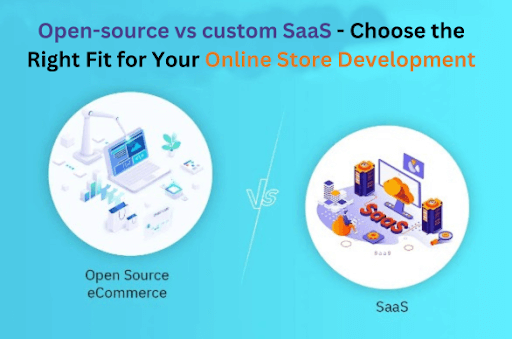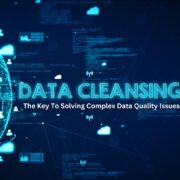When it comes to eCommerce website development, the decision between open-source solutions and custom Software as a Service (SaaS) solutions is critical. Open-source offers flexibility and cost-effectiveness, whereas custom SaaS solutions provide managed services and scalability.
Explore this comparison that aims to guide businesses to choose the right one tailored to their unique requirements and long-term goals.
The difference between open-source and custom SaaS solutions
Going with open-source solutions provides full accessibility of the eCommerce platform’s source code to your development teams. It is available at no cost, allowing anyone to view, modify, and distribute it. This facilitates developers to build a website from scratch according to their needs. Nevertheless, this approach will be challenging for non-tech users, and consequently, employing eCommerce web developers may be necessary. Moreover, anyone choosing open-source solutions will be required to handle aspects like hosting, security, and maintenance on their own or by third-party services. Some of the examples of open-source eCommerce platforms are Magento, WooCommerce, OpenCart, and PrestaShop.
Software as a Service (SaaS) solutions refers to a model where businesses use an online software platform by paying a monthly or annual subscription fee. They won’t be required to manage hosting and eCommerce infrastructure on their servers. This makes it easier for businesses to establish and manage their online presence without grappling with the complexities of self-hosted solutions. Popular SaaS eCommerce platforms include Shopify, BigCommerce, and Magento Commerce Cloud.
Open-source vs. custom SaaS solutions: A detailed factor-based comparison
Customization needs
- Open-source solutions
With accessible source code, open-source software provides unparalleled flexibility for tailoring an eCommerce website to specific needs. After setting up an online store using an open-source platform, you can customize it according to the growing needs and customer preferences. This eCommerce site development approach gives full control over the site’s UI/UX, and this is the reason many developers usually prefer it. However, code modifications are complex for non-tech users with no in-house support to do it. They will have to hire eCommerce web developers to cater to their future requirements if choosing open-source solutions. - Custom SaaS solutions
A custom SaaS solution offers a degree of customization but may be limited by the provider’s predefined features. Altering source code is not permitted in all SaaS platforms, but some offer a level of openness through APIs. This gives integration possibilities and grants users more flexibility in tailoring the software to their needs.
Cost and resources
- Open-source solutions
They are free to use, providing a cost-effective starting point for businesses with limited budgets. However, as a business owner, if you choose open-source solutions, you can expect to pay for the following –- Agency or freelance web development fees – The development and customization of an open-source solution often require skilled professionals. Businesses with no in-house support may be required to engage with an eCommerce development company or freelance developers. Leveraging their expertise incurs fees in tailoring the platform to meet specific business requirements.
- Hosting provider fees – Businesses need to consider expenses related to hosting services. Whether utilizing cloud-based solutions or traditional hosting providers, fees will be incurred based on factors such as server resources, bandwidth usage, and additional services.
- Maintenance fees – The ongoing maintenance of an open-source platform is essential for ensuring its performance, security, and compatibility with evolving requirements. Therefore, you must consider fees for software updates, bug fixes, and general system maintenance to ensure optimal performance.
- Custom SaaS solutions
SaaS platforms involve hosting, security, automatic updates, and vendor management, thus, letting business owners utilize resources toward marketing, sales, and other necessary business functions. But they still can expect to pay for the following –- Subscription fees – Users need to pay a subscription fee to access and use the SaaS platform. However, it often includes ongoing updates, maintenance, and customer support.
- Agency or freelance web development fees – Customization beyond the built-in features of a SaaS platform may require technical expertise. This, in turn, requires non-tech users to hire skilled professionals from an eCommerce development company or freelancers to tailor the SaaS solution to their specific requirements.
- Third-party integrations – While SaaS solutions are designed to work seamlessly within their ecosystem, integrating with external systems might be limited. Therefore, third-party integrations with SaaS platforms may involve additional costs.
Security
- Open-source solutions
While the code transparency of open-source software allows for rapid identification of vulnerabilities, the responsibility of securing the system falls on the end users. They need to perform regular security audits and keep adherence to security best practices. This requires additional effort as organizations will have to be proactive to maintain a robust and compliant system. - Custom SaaS solutions
Users can rely on service providers to take care of the security of their SaaS platform. Compliance with industry regulations is often streamlined as providers implement measures to meet these standards. However, before relying on a SaaS solution, organizations will be required to verify the provider’s security practices to guarantee a secure and compliant environment.
Scalability
- Open-source solutions
Open-source software provides the advantage of scalability by allowing modifications to accommodate business expansions. However, the responsibility for managing scalability falls on the organization. It requires careful planning and execution and may demand additional resources and expertise to maintain optimal performance during periods of high usage and business expansions. - Custom SaaS solutions
Custom SaaS solutions with their predefined infrastructure often handle scalability seamlessly. SaaS providers design their platforms with scalability in mind and give a robust infrastructure that automatically adjusts to accommodate increased user loads or growing data requirements.
Maintenance and support
- Open-source solutions
Maintenance and support in open-source software require a hands-on approach from the organization or its development team. Though, due to high community support, the updates and patches are often available promptly, it is the responsibility of the business to implement these changes. - Custom SaaS solutions
Here the SaaS provider manages maintenance for custom SaaS solutions. It frees organizations from the burden of handling routine maintenance tasks, such as updates, patches, and system optimizations. Providers often offer customer support services, including troubleshooting, issue resolution, and user assistance. It ensures that the SaaS platform remains up-to-date and operational without requiring extensive in-house efforts.
Who should choose open-source solutions?
While open-source platforms offer numerous benefits, they may not be the best fit for every scenario. Factors such as technical expertise and long-term support considerations should be carefully evaluated before deciding to adopt them.
Here are the types of users who may find open-source solutions particularly beneficial:
- Developers and tech enthusiasts
- Small businesses with budget constraints
- Security conscious users
- Startups and innovators
- Organizations with unique or high customization requirements
Who should choose custom SaaS solutions?
Custom software may be suitable for organizations that prioritize scalability and do not want the hassle of managing hosting, security, and updates. Here are the users that will find a custom SaaS software best for their needs –
- Businesses with limited technical expertise
- Organizations requiring specific integrations with existing systems
- Enterprises seeking a scalable solution tailored to their growth
- SMEs looking for easy platform setup
Wrapping up
Hopefully, the above information provided you with a clear idea of choosing between open-source solutions and custom SaaS solutions.
Choosing open-source software for eCommerce website development is like building a house from the ground. Though you will get what you desire, it will require a lot like hiring eCommerce web developers and investments in hosting, security, and maintenance. Conversely, in case of time and resource constraints, custom SaaS solutions can be the way to go but limit you in customization and flexibility.
As there is no one-size-fits-all platform, businesses may find one option more suitable than the other and vice versa, as it all depends on their specific needs and circumstances.






Comments